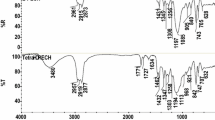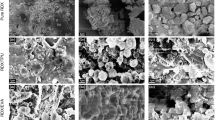Abstract
As a kind of energetic plasticizer, ester-terminated glycidyl azide polymer (GAPE) has a potential for being mixed with energetic binder glycidyl azide polymer (GAP) to enable the system a higher overall energy level. To determine whether the mentioned system can be put into practical use, TG-DSC-MS-FTIR was applied to characterize thermal behaviours of GAP, GAPE and 50/50 GAP/GAPE mixture, and VST was used to decide the compatibility of GAP and GAPE. It turns out that GAPE is compatible with GAP. Decomposition of the mixture can be divided into two steps, rapid decomposition with obvious heat release and self-catalysis decomposition, showing the same tendency with the decomposition of GAP and GAPE. Based on the heating rate of 2, 5, 10 and 15 °C min−1, the kinetics triplets of the three samples’ decomposition were calculated, and the decomposition mechanism was obtained. Results show that the decomposition process was governed by the decomposition of GAPE, which started with the scission of –N3. The critical temperatures of thermal explosion of GAP, GAPE and the mixture were also calculated. Substituting the critical temperature to the reaction rate equation to verify the decomposition process, the dominating role of GAPE in this decomposition of mixture was affirmed. Therefore, GAP/GAPE mixture has a promising future in high-energy propellants/explosives.







Similar content being viewed by others
References
Manu SK, Varghese TL, Mathew S, et al. Studies on structure property correlation of cross-linked glycidyl azide polymer. J Appl Polym Sci. 2009;114(6):3360–8.
Gaur B, Lochab B, Choudhary V, et al. Azido polymers-energetic binders for solid rocket propellants. J Macromol Sci Part C. 2003;43(4):505–45.
Kubota N, Sonobe T. Combustion mechanism of azide polymer. Propellants Explos Pyrotech. 1988;13(6):172–7.
Tang CJ, Lee Y, Litzinger TA. Simultaneous temperature and species measurements of the glycidyl azide polymer (GAP) propellant during laser-induced decomposition. Combust Flame. 1999;117(1–2):244–56.
Deng J, Li G, Xia M, et al. Improvement of mechanical characteristics of glycidyl azide polymer binder system by addition of flexible polyether. J Appl Polym Sci. 2016;133(35):1–7.
Frankel MB, Grant LR, Flanagan JE. Historical development of glycidyl azide polymer. J Propuls Power. 2012;8(3):560–3.
Kubota N, Kuwahara T. Combustion of energetic fuel for ducted rockets (I). Propellants Explos Pyrotech. 1991;16(2):51–4.
Kubota N, Miyata K, Kuwahara T, et al. Energetic solid fuels for ducted rockets (II). Propellants Explos Pyrotech. 1991;16(6):287–92.
Keiichi H, Motoyasu K. Combustion mechanism of glycidyl azide polymer. Propellants Explos Pyrotech. 1996;21(3):160–5.
Menke K, Eisele S. Rocket propellants with reduced smoke and high burning rates. Propellants Explos Pyrotech. 1997;22(3):112–9.
Vandenberg, E.J. Polyethers containing azidomethyl side chains. US, US3645917. 1972.
Frankel MB, Grant LR, Flanagan JE. Historical development of glycidyl azide polymer. J Propul Power. 2012;8(3):560–3.
You JS, et al. A kinetic study of thermal decomposition of glycidyl azide polymer (GAP)-based energetic thermoplastic polyurethanes. Macromol Res. 2010;18(12):1226–32.
Sekkar V, Bhagawan SS, Prabhakaran N. Polyurethanes based on hydroxyl terminated polybutadiene: modelling of network parameters and correlation with mechanical properties. Polymer. 2000;41(18):6773–86.
Selim K, Özkar S, Yilmaz L. Thermal characterization of glycidyl azide polymer (GAP) and GAP-based binders for composite propellants. J Appl Polym Sci. 2000;77(3):538–46.
Stacer RG, Husband DM. Molecular structure of the ideal solid propellant binder. Propellants Explos Pyrotech. 1991;16(4):167–76.
Ampleman, G. Synthesis of a diazido terminated energetic plasticizer. US, US5124463. 1992.
Flanagan, J.E. Glycidyl azide polymer esters. US, US4938812. 1990.
Du XS. Advances on research and development in endurance plasticizer in China. Plast Addit. 2009;77:9–12.
Manu SK, Varghese TL, Mathew S, Ninan KN. Compatibility of glycidyl azide polymer with hydroxyl terminated polybutadiene and plasticizers. J Propuls Power. 2009;25(2):533–6.
Fazlıoğlu H, Hacaloğlu J. Thermal decomposition of glycidyl azide polymer by direct insertion probe mass spectrometry. J Anal Appl Pyrol. 2002;63(2):327–38.
Korobeinichev OP, et al. Mass spectrometric study of combustion and thermal decomposition of GAP. Combust Flame. 2002;129(1):136–50.
Arisawa H, Brill TB. Thermal decomposition of energetic materials 71: structure-decomposition and kinetic relationships in flash pyrolysis of glycidyl azide polymer (GAP). Combust Flame. 1998;112(4):533–44.
Sun Y, Li S. The effect of nitrate esters on the thermal decomposition mechanism of GAP. J Hazard Mater. 2008;154(1):112–7.
Shen SM, Leu AL, Chen SI, Yeh HC. Thermal-characteristics of GAP, GAP/BDNPA/BDNPF and PEG/BDNPA/BDNPF and the energetic composites thereof. Thermochim Acta. 1991;180:251–8.
De Klerk W, Meer NVD, Eerligh R. Microcalorimetric study applied to the comparison of compatibility tests (VST and IST) of polymers and propellants. Thermochim Acta. 1995;269–70(1):231–43.
Pei JF, et al. Compatibility study of BAMO–GAP copolymer with some energetic materials. J Therm Anal Calorim. 2016;124(3):1301–7.
Zhang W, Jiao Q, Yan S, Ren H, Guo X. Influence of purification of energetic binders by vacuum rotary evaporation in different conditions. In: The 20th seminar new trends in research of energetic materials, Pardubice CZ; 2017.
Liu ZR. Thermal analyses for energetic materials. Beijing: National Defense Industry Press; 2008.
You JS, et al. Thermal decomposition kinetics of GAP ETPE/RDX-based solid propellant. Thermochim Acta. 2012;537:51–6.
Sreekumar P, Ang HG. Thermal decomposition kinetics of a mixture of energetic polymer and nitramine oxidizer. Thermochim Acta. 2007;459:26–33.
Kissinger HE. Reaction kinetics in differential thermal analysis. Anal Chem. 1957;29(11):1702–6.
Ozawa T. A new method of analyzing thermogravimetric data. Bull Chem Soc Jpn. 1965;38(11):1881–6.
Ozawa T. Kinetic analysis of derivative curves in thermal analysis. J Therm Anal. 1970;2(3):301–24.
Hu R, Gao S, Zhao F, Shi Q, Zhang T, Zhang J. Thermal analysis kinetic. 2nd ed. Beijing: Science Press; 2008 (in Chinese).
Šatava V, Šesták JJ. Computer calculation of the mechanism and associated kinetic data using a non-isothermal integral method. Therm Anal. 1975;8(3):477–89.
Agrawal R. A new equation for modeling nonisothermal reactions. J Therm Anal Calorim. 1987;32(1):149–56.
Tonglai Z, et al. The estimation of critical temperatures of thermal explosion for energetic materials using non-isothermal DSC. Thermochim Acta. 1994;244:171–6.
Huang C-C, Tzueng-Shien W. A simple method for estimating the autoignition temperature of solid energetic materials with a single non-isothermal DSC or DTA curve. Thermochim Acta. 1994;239:105–14.
Yi J-H, et al. Thermal behaviors, non isothermal decomposition reaction kinetics, thermal safety and burning rates of BTATz-CMDB propellant. J Hazard Mater. 2010;181(1):432–9.
Author information
Authors and Affiliations
Corresponding author
Rights and permissions
About this article
Cite this article
Zhang, W., Ren, H., Sun, Y. et al. Effects of ester-terminated glycidyl azide polymer on the thermal stability and decomposition of GAP by TG-DSC-MS-FTIR and VST. J Therm Anal Calorim 132, 1883–1892 (2018). https://doi.org/10.1007/s10973-018-7063-8
Received:
Accepted:
Published:
Issue Date:
DOI: https://doi.org/10.1007/s10973-018-7063-8




